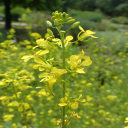Search
About Brassica juncea
Brassica juncea (L.) Czern & Coss is a diverse and important agricultural species. An allotetraploid (AABB, 2n = 36), B. juncea derived from interspecific hybridization between the diploid progenitors Brassica rapa (AA, 2n = 20) and Brassica nigra (BB, 2n = 16)2. Four subspecies have been proposed based on crop use and morphology: juncea (seed mustard), integrifolia (leaf mustard), napiformis (root mustard) and tumida (stem mustard). B. juncea has a wide geographic range as native plants, adapted crops and introduced weeds, spanning the continents of Asia, Europe, Africa, America and Australia. B. juncea is an important oilseed crop in India, Bangladesh, China and Ukraine, and is recently also gaining importance in Canada and Australia. Meanwhile, it is grown as a condiment in Europe, North America, Argentina and China. Root mustard is distributed in Mongolia and northeastern China, whereas leaf mustards are most common in China and Southeast Asia. Brassica juncea is regarded as one of the earliest domesticated plants, with mustard mentioned as a condiment in Sanskrit and Sumerian texts from as early as 3,000 BC.
Taxonomy ID 3707
Data source HUNAU
Comparative genomics
What can I find? Homologues, gene trees, and whole genome alignments across multiple species.
 More about comparative analyses
More about comparative analyses
 Phylogenetic overview of gene families
Phylogenetic overview of gene families
 Download alignments (EMF)
Download alignments (EMF)
Variation
This species currently has no variation database. However you can process your own variants using the Variant Effect Predictor:






 Display your data in Ensembl Plants
Display your data in Ensembl Plants

 Update your old Ensembl IDs
Update your old Ensembl IDs

![Follow us on Twitter! [twitter logo]](/i/twitter.png)
